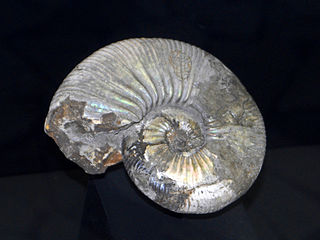
Acanthohoplites is an extinct genus of ammonites in the family Parahoplitidae that lived in the Aptian and Early Albian stages of the Early Cretaceous.
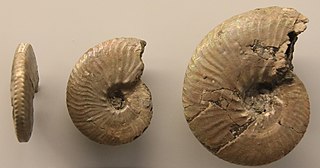
Anahoplites is a genus of rather involute, compressed hoplitid ammonites with flat sides, narrow flat or grooved venters, and flexious ribs or striae arising from weak umbilicle tubercles that end in fine dense ventrolateral nodes. The elements of their sutures are short, wide and jaggedy. Specimens of Annahoplites have diameters typically in the range of 4–6 centimetres (1.6–2.4 in) although some with diameters of as much as 19 centimetres (7.5 in) have been reported. The genus lived during the Cretaceous, from the Middle to the late Albian.

Astieridiscus is an extinct lower Cretaceous ammonite. Its shell evolute, covered by dense, simple or branching, slightly flexuous ribs. The sides are slightly flattened, the venter rounded. No umbilical or other tubercles except on innermost whorl. Superficially resembles Olcostephanus.
Bisatoceratidae is a family of Late Paleozoic ammonites now included in the Thalassoceratoidea characterized by thick-discoidal to subglobular, involute shells in which lobes are simple. Some forms have spiral ornamentation.

Desmoceratidae is a family belonging to the ammonite superfamily Desmoceratoidea. They are an extinct group of ammonoids, shelled cephalopods related to squid, belemnites, octopuses, and cuttlefish, and more distantly to the nautiloids, that lived between the Lower Cretaceous and Upper Cretaceous.
Magharina small upper Bajocian genus of ammonite with a small smooth involute shell having a single keel along the venter and extremely simple sutures. Found in Egypt. The type species is M. magharensis.
Lissoceras is an involute, smooth or finely vetrolaterally ribbed, ammonite with a blunt, un-keeled venter, included in the Haploceratidae, that lived from the Lower Bajocian - Middle Oxfordian in what is now Europe, south Asia, and southern Alaska.
Heteroceras is a genus of Lower Cretaceous heteromorph ammonites belonging to the ancyloceratoidean family, Heteroceratidae.
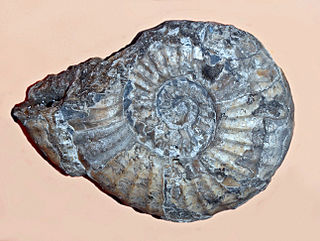
Arietitidae is a family of true ammonites that make up part of the superfamily Psiloceratoidea, named after the type genus Arietites. They comprise medium-size to large or gigantic genera which in general are strongly ribbed, tuberculate in some, with keeled or grooved and keeled venters, and well differentiated ammonitic sutures. The aptycus is single valved with a shiny, concentrically striated surface.
Neolissoceras is a genus of haploceratid ammonites with a smooth, compressed, flat-sided shell with a flatly rounded venter and distinct umbilical margin, from the Upper Jurassic (Tithonian) - Lower Cretaceous (Hauterivian) of southern Europe, Madagascar, and India.

Idoceras is a genus of perisphictacean ammonite, belonging to the Perisphinctidae subfamily Idoceratinae. The genus is known from the Upper Jurassic, with a widespread distribution. Shells of Idoceras are evolute, with a wide umbilicus; ribbing strong, bifurcate high on flanks. Suture simpler than in the similar Ataxioceras.
The Aspidoceratinae is a subfamily in the perisphictacean ammonite family, Aspidoceratidae found world wide in middle and upper Jurassic sediments.

Perisphinctidae is a family of Middle and Upper Jurassic discoidal ammonites in the order Ammonitida. They have a shell morphology that is mostly evolute, typically with biplicate, simple, or triplicate ribbing. Large forms have simple apertures and smooth body chambers while small forms have lappets and ribbed body chambers.

Neocomites is a genus of ammonite from the Lower Cretaceous, Berriasian to Hauterivian, and type genus for the Neocomitidae.

Neocomitidae is a family of Lower Cretaceous ammonitids comprising genera with strongly ribbed evolute to smooth, fairly involute shells.

Holcodiscidae is an ammonite family placed in the superfamily Desmoceratoidea.
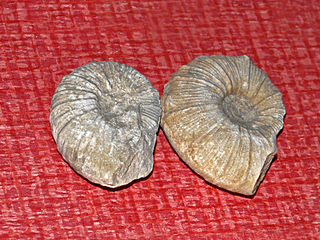
Holcodiscus is an extinct ammonite genus placed in the family Holcodiscidae. Species in this genus were fast-moving nektonic carnivores. The type species of the genus is Ammonites caillaudianus.

Parkinsoniidae is a family of ammonites belonging to the order Ammonitida. The cephalopod family lived from the Bajocian stage to the Bathonian age of the Middle Jurassic.
Euomphaloceratinae is a subfamily of Upper Cretaceous ammonites included in the Acanthoceratidae, characterized by generally evolute shells with quadrate whorl sections that are strongly ribbed. Sutures are ammonitic, but not overly complex.
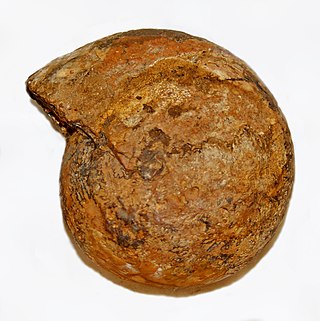
Halorites is an extinct genus of Triassic ammonoids belonging to the family Haloritidae.













